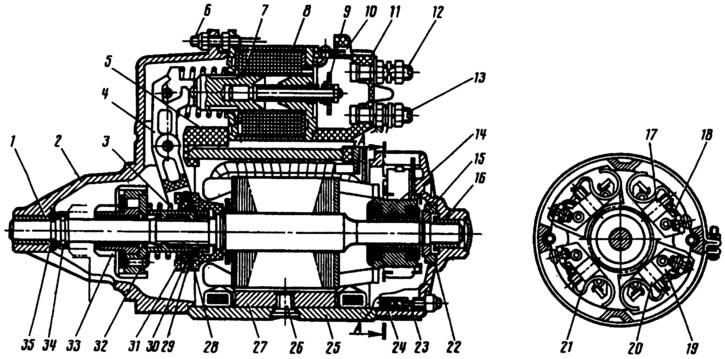
Pic. 232. Starter ST-221:
1 - bearing bushing; 2 - starter cover on the drive side; 3 - buffer spring; 4 - driving lever; 5 - rubber plug; 6 - relay coupling bolt; 7 - relay armature; 8 - relay yoke; 9 - contact plate; 10 - plug «50» relay winding output; 11 - relay cover; 12 - top contact bolt; 13 - lower contact bolt; 14 - collector; 15 - armature brake disc; 16 - armature bearing bushing; 17 - negative brush; 18 - negative brush holder; 19 - positive brush holder; 20 - gender (suspicious brush; 21 - brush spring; 22 - brake disc cover; 23 - tie rod; 24 - cover from the side of the collector; 25 - body; 26 - pole fastening screw; 27 - stator pole; 28 - travel limiter of the drive gear; 29 - restrictive disk; 30 - driving ring; 31 - centering disk; 32 - overrunning clutch; 33 - drive gear; 34 - restrictive ring; 35 - adjusting washers.
The covers and the starter housing are pulled together with two studs 23, which are screwed into the cover 2. Four poles 27 are installed in the housing 25 - two with serial windings connected in series with the armature, and two with tung windings (coils), connected in parallel.
The starter armature consists of a shaft, a core with a winding and a collector 14. The armature shaft rotates in two porous ceramic-metal bushings 1 and 16, pressed into the starter covers and soaked in oil. The axial free play of the armature shaft is regulated by the selection of washers 35 and should be in the range of 0.07-0.7 mm. At the front end of the armature shaft, a starter drive is installed, consisting of a freewheel roller clutch 32 and gear 33.
Four brush holders with copper-graphite brushes are riveted to cover 24. Two brush holders 19 are isolated from the cover by plastic plates. These are brush holders for positive brushes. The conclusions of the serial stator coils are attached to them. The other two brush holders 18 are attached directly to the cover and are therefore connected to the housing. One of them is connected to the output of the shunt coils.
A starter traction relay is attached to cover 2, consisting of an armature 7, a winding, a contact plate 9 and a cover 11 with contact bolts 12. The traction relay turns on the starter and engages gear 33 with the flywheel crown. Since 1983, a traction relay has been used with two windings - retracting and holding. When the starter is turned on, both windings work first. And after closing the contacts of the traction relay, the retracting winding is turned off.
Since 1986, a starter of the type (models) 35.3708, which has an end collector, as well as three serial stator windings and one shunt winding. The end collector is made in the form of a plastic disk with copper plates embedded in it. Otherwise, the design of the starter 35.3708 is the same as that of the ST-221 starter.
The starter switching circuit is shown in fig. 233. It is the same on VAZ-2105, -2104 cars. Since 1986, an additional relay 4 type 113.3747-10 has been included in the circuit, which is installed on the right wheel mudguard in the engine compartment. Until 1986, the voltage from the plug 50 of the ignition switch was applied directly to the plug 50 of the starter traction relay.

Pic. 233. Starter connection diagram:
1 - generator; 2 - battery; 3 - starter; 4 - additional starter enable relay; 5 - mounting block; 6 - ignition switch.
